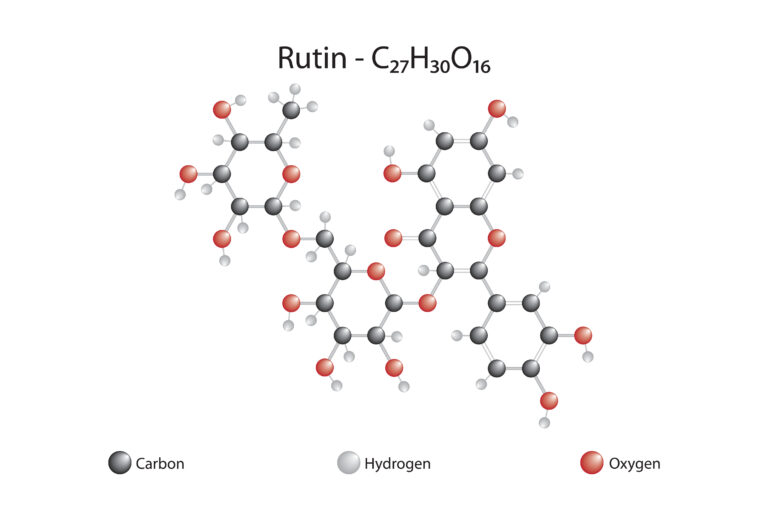Glycosylrutin

Glycosylrutin is a natural flavonoid glycoside that is obtained from the Japanese pagoda tree. The tree, with the botanical name Sophora japonica, originates from Asia and has now become a popular bee-feeding plant in our region as well. It is considered to be particularly resistant to drought, heat and exhaust fumes, which is partly thanks to the flavonoid, and is therefore often used for extreme inner-city planting.
Glycosylrutin is sometimes also called rutinose and has a molecular weight of 664.57 g/mol. The substance occurs either as a crystalline solid or as a yellowish-brown powder and is soluble in both water and ethanol. Its pH value is between 5.0 and 7.0. It is important that the active ingredient is stored at room temperature because it is quite sensitive to high temperatures. Changes in pH should also be avoided, which means that storage in an acidic to neutral pH range is recommended. Under optimal conditions and in aqueous and alcoholic solutions, glycosylrutin is characterised by very good stability.
The areas of application
Glycosylrutin is used relatively frequently in cosmetics. We find the substance mainly in serums, creams and lotions that are intended to reduce the signs of aging as part of skin care. It can help to strengthen the capillaries of the skin and improve blood circulation in the skin. It also has very good antioxidant properties, because it strengthens the natural immune system of our skin and helps to protect it from oxidative stress and damage caused by free radicals. Its effectiveness has been demonstrated in both in vitro and in vivo studies. Further studies have shown that glycosylrutin can even be used to prevent certain dermatological diseases such as polymorphic light eruption (source: ). The antioxidant is also said to offer promising results in the preventive treatment of premature skin ageing caused by light.
As in vivo evaluations have shown, the substance is a very well-tolerated cosmetic ingredient, provided that the recommended concentrations are not exceeded. Since the epidermal bioavailability is very high, more and more cosmetics manufacturers are relying on the valuable natural flavonoid glycoside. We sometimes also find it in vitamin preparations and dietary supplements.
The most common cosmetic applications of glycosylrutin
Anti-aging products
Glycosylrutin is a proven and popular active ingredient in anti-aging serums, creams and masks. With its help, not only can the elasticity of the skin be improved, but fine lines and wrinkles can also be reduced with consistent use.
Products for skin lightening
Hyperpigmentation and dark spots are often a source of great distress for those affected. Cosmetic products with glycosylrutin can lighten the skin and reduce both hyperpigmentation and dark spots.
The active ingredient is very often found in corresponding products and ensures positive results in many cases.
Sun care products
It has already been demonstrated that glycosylrutin can reduce the effects of harmful UV radiation on our skin. Cosmetics manufacturers are now also aware that the active agent can at least minimise, if not completely rule out, skin damage caused by exposure to the sun. That is why it is a popular ingredient in high-quality sun care products.
Moisturising care
It is important that the skin is optimally supplied with moisture to ensure a fresh, healthy and vital appearance. Glycosylrutin is able to support the skin’s moisture barrier and retain skin moisture. The active ingredient is therefore suitable for all cosmetic products that moisturise the skin and make it supple and elastic.
Products for soothing the skin
Since glycosylrutin also has anti-inflammatory properties, the substance is the ideal active ingredient for cosmetic products that are designed to gently soothe irritated or sensitive skin. These include, in particular, serums, masks and creams. The application not only soothes the skin, but also reduces redness.
Glycosylrutin: a profile
INCI: Glycosylrutin
Chemical name: 4 (G) – a-D-glucopyranosylrutin
CAS number: 130603-71-3
Description: a natural flavonoid and potent antioxidant with high epidermal bioavailability
Molecular formula: C33H40O21
Boiling point: 1134.1 ± 65.0 °C
Properties: highly stable, odourless, very soluble
Applications: anti-ageing products, moisturisers, sun protection and skin regeneration after sunburn
Glycosylrutin as an innovative active agent for high-quality cosmetics
This natural compound offers many advantages for skin care, especially in the anti-ageing sector, for sun protection and for moisturising care. It can even inhibit inflammations and stimulate the production of collagen. The active agent is very well tolerated and is characterised by excellent epidermal bioavailability. Are you interested in modern cosmetic formulations with glycosylrutin? We at Cosmacon are happy to answer any questions you may have!